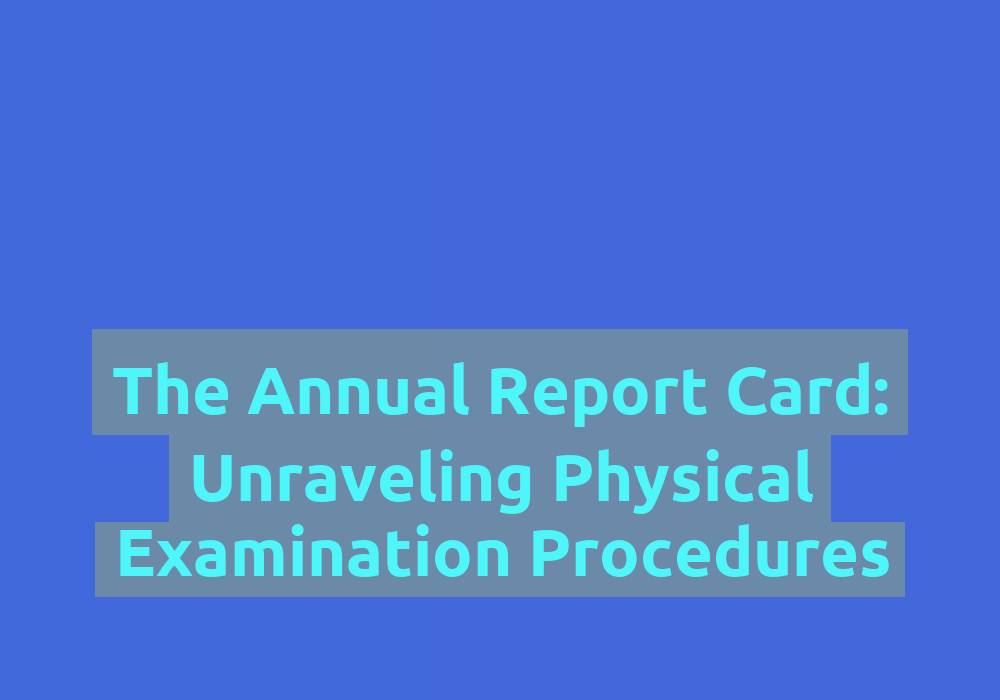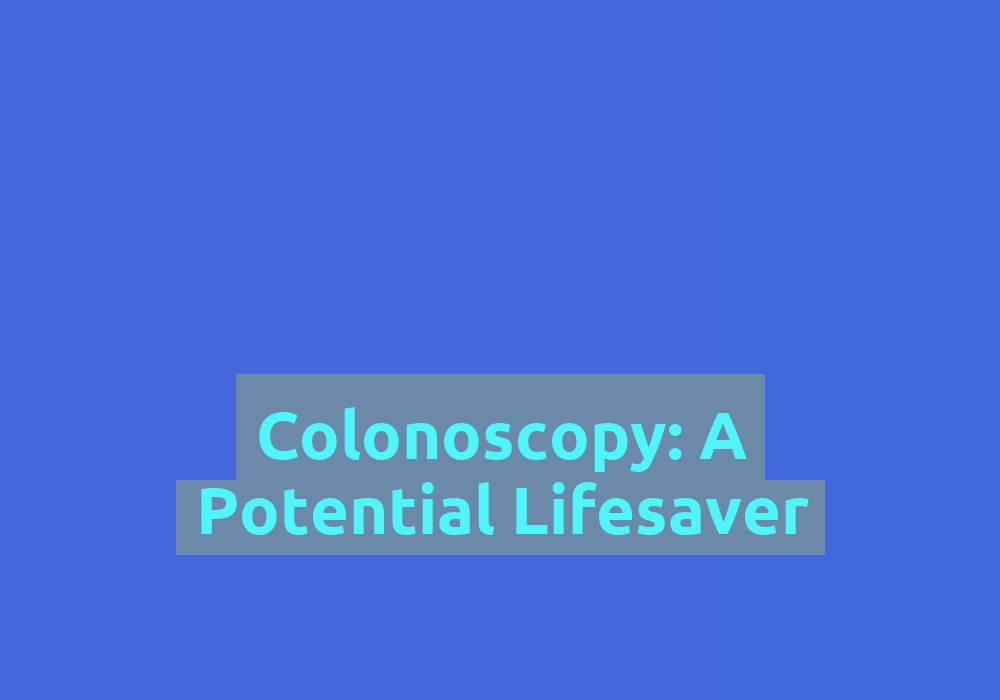From Dread to Relief: Demystifying Your Upcoming Colonoscopy

A colonoscopy is a medical procedure that allows doctors to examine the inner lining of your large intestine (colon) for any abnormalities or signs of disease. While it may sound intimidating, understanding the process and purpose of a colonoscopy can help alleviate any fears or concerns you may have. In this article, we will demystify the procedure and provide you with all the necessary information to approach your upcoming colonoscopy with confidence and relief.
What is a Colonoscopy?
A colonoscopy is a diagnostic procedure performed by a gastroenterologist, a specialist in digestive diseases. It involves using a long, flexible tube called a colonoscope to examine the inside of your colon. The colonoscope is equipped with a light and a camera, which allows the doctor to visualize the colon in real-time and identify any abnormalities or potential issues.
During a colonoscopy, the doctor may also perform additional procedures such as taking biopsies or removing polyps. Biopsies involve taking small tissue samples from the colon lining to be further analyzed in a laboratory. Polyps, which are abnormal growths in the colon, can be removed during the procedure to prevent them from becoming cancerous.
Why is a Colonoscopy Performed?
There are several reasons why a doctor may recommend a colonoscopy. Understanding these reasons can help you recognize the importance of the procedure and alleviate any concerns you may have. The most common indications for a colonoscopy include:
-
Screening for Colorectal Cancer: Colonoscopy is considered the gold standard for detecting and preventing colorectal cancer, the third most common type of cancer worldwide. It allows doctors to identify precancerous polyps or growths in the colon and remove them before they become cancerous. By detecting and removing these polyps early, the risk of developing colorectal cancer can be significantly reduced.
-
Investigating Digestive Symptoms: If you’ve been experiencing persistent abdominal pain, rectal bleeding, chronic diarrhea, or unexplained weight loss, a colonoscopy can help identify the underlying cause of these symptoms. It allows the doctor to visualize the colon and identify any abnormalities or inflammation that may be contributing to your digestive issues.
-
Monitoring Inflammatory Bowel Disease (IBD): For individuals with inflammatory bowel diseases such as Crohn’s disease or ulcerative colitis, regular colonoscopies are often recommended to monitor the condition and detect any changes or complications. These conditions can cause inflammation and damage to the colon lining, which can be assessed through colonoscopy.
-
Evaluating Anemia or Blood Loss: If you have been diagnosed with anemia or have experienced significant blood loss, a colonoscopy can help determine whether the bleeding is coming from the colon. The doctor can visually inspect the colon for any signs of bleeding or abnormalities that may be causing your condition.
-
Family History of Colorectal Cancer or Polyps: If you have a close relative who has been diagnosed with colorectal cancer or polyps, your doctor may recommend a colonoscopy to assess your risk and screen for any abnormalities. Having a family history of these conditions increases your likelihood of developing them as well.
By understanding these reasons, you can see that a colonoscopy is not only a diagnostic tool but also a preventive measure that can potentially save lives. It is crucial to follow through with the recommended colonoscopy if your doctor suggests it.
How to Prepare for a Colonoscopy
Proper preparation is crucial to ensure a successful and accurate colonoscopy. Here are some important steps to follow:
- Dietary Restrictions: Your doctor will provide you with specific dietary instructions to follow in the days leading up to your colonoscopy. Typically, you will be required to follow a clear liquid diet the day before the procedure and avoid foods with high fiber content. This helps ensure that your colon is empty and clean for the examination.
During the clear liquid diet, you can consume clear liquids such as broth, clear juices, tea, and gelatin. It is important to avoid any solid foods or liquids that are colored red or purple, as they can interfere with the clarity of the colon during the procedure.
- Bowel Preparation: Cleansing your colon is essential for a clear and unobstructed view during the colonoscopy. Your doctor will prescribe a bowel preparation regimen, which usually involves drinking a special solution or taking laxatives to help empty your bowels. This process may start a day or two before the procedure.
The bowel preparation solution or laxatives work to flush out the stool from your colon, ensuring that it is clean and free of any obstructions. It is important to follow the instructions provided by your doctor carefully to ensure the effectiveness of the bowel preparation.
- Medication Adjustments: Inform your doctor about any medications you are currently taking. You may need to temporarily stop certain medications, especially blood thinners, nonsteroidal anti-inflammatory drugs (NSAIDs), or iron supplements, as they can increase the risk of bleeding during the procedure. Your doctor will provide specific instructions regarding medication adjustments before the colonoscopy.
It is important to communicate openly with your doctor about all the medications you are taking, including prescription medications, over-the-counter drugs, and any supplements. Your doctor will guide you on which medications to stop and when to resume them after the procedure.
- Arrangements for Transportation: Since you will be sedated during the colonoscopy, it is important to arrange for someone to drive you home afterward. The sedatives can impair your coordination and judgment, making it unsafe to operate a vehicle. It is recommended to have a family member or a trusted friend accompany you to the procedure and drive you home afterward.
Ensuring that you have a reliable transportation plan in place will help you relax and focus on the procedure without any added stress. It is always better to be safe and have someone responsible to assist you during this time.
By following these preparation steps, you can ensure that your colonoscopy proceeds smoothly and provides accurate results. Proper preparation is key to the success of the procedure and allows the doctor to perform a thorough examination of your colon.
What to Expect During the Procedure
Knowing what to expect during a colonoscopy can help alleviate any anxiety or uncertainty you may have. Here’s a breakdown of what typically happens during the procedure:
- Anesthesia: Most colonoscopies are performed with the use of sedation or anesthesia to ensure your comfort throughout the procedure. The type of anesthesia used may vary, ranging from mild sedatives that keep you awake but relaxed to deeper sedation that causes you to sleep through the entire procedure. Your doctor will determine the appropriate level of sedation based on your individual needs and preferences.
The purpose of anesthesia is to ensure that you experience little to no discomfort during the colonoscopy. It allows the doctor to perform the examination smoothly while you remain relaxed and pain-free.
- Monitoring Vital Signs: Your blood pressure, heart rate, and oxygen saturation levels will be closely monitored during the colonoscopy to ensure your safety and well-being. A healthcare professional will be present throughout the procedure to monitor these vital signs and address any concerns that may arise.
Monitoring your vital signs is a standard practice during any medical procedure. It helps ensure that you are stable and responding well to the sedation and the colonoscopy itself.
- Insertion of the Colonoscope: The doctor will gently insert the lubricated colonoscope through your anus and advance it slowly into your colon. This process is done carefully and gradually to minimize any discomfort or injury. The camera at the tip of the colonoscope will transmit images to a monitor, allowing the doctor to examine the colon lining.
The insertion of the colonoscope may cause some pressure or mild discomfort, but it should not be excessively painful. The doctor will work to make you as comfortable as possible throughout the procedure.
- Air or Water Insufflation: To obtain better visibility, the doctor may introduce air or water into your colon. This can cause a sensation of bloating or cramping, but it is typically mild and temporary. The air or water helps to expand the colon and provide a clearer view of the colon lining for the doctor.
It is important to communicate any discomfort or sensations you experience during the procedure to the healthcare professionals present. They can make adjustments or provide additional support to ensure your comfort.
- Biopsy or Polyp Removal: If the doctor identifies any abnormalities, such as polyps or suspicious areas, they may take a biopsy or remove the polyps during the procedure. These samples will be sent to a laboratory for further analysis. Biopsies help determine whether any abnormal cells are present, while polyp removal reduces the risk of these growths developing into cancer.
The doctor will use specialized tools to perform biopsies or remove polyps, and these procedures are typically painless. Any discomfort experienced is usually mild and temporary.
- Duration of the Procedure: A typical colonoscopy takes around 30 minutes to an hour, depending on various factors, including the findings and any necessary interventions. The duration may vary from person to person, and the doctor will take the necessary time to perform a thorough examination.
The duration of the procedure also depends on factors such as the complexity of the case and the presence of any additional procedures, such as biopsies or polyp removal. It is important to remain patient and trust that the doctor will take the time required to complete a comprehensive evaluation.
After the Colonoscopy
Once the colonoscopy is completed, you will be monitored until the effects of the sedation wear off. Here’s what you should expect afterward:
- Recovery Time: It may take some time for the sedation to wear off completely, so you will need to rest and recover at the facility for a while. The healthcare professionals will monitor your condition until you are stable and ready to be discharged. It is important to arrange for someone to drive you home afterward, as the effects of the sedation can impair your ability to drive safely.
It is normal to feel groggy or drowsy after the procedure. Allow yourself the necessary time to recover and regain your energy before resuming your usual activities.
- Possible Side Effects: It is common to experience mild side effects after a colonoscopy, such as bloating, gas, or mild abdominal discomfort. These symptoms usually resolve within a few hours. Drinking plenty of fluids and moving around gently can help alleviate these discomforts. However, if you experience severe pain, heavy bleeding, or any other concerning symptoms, it is important to contact your healthcare provider immediately.
The side effects experienced after a colonoscopy are typically temporary and subside on their own. It is important to listen to your body and take care of yourself during the recovery period.
- Post-Procedure Instructions: Your doctor will provide you with specific instructions regarding diet, physical activity, and medication after the colonoscopy. It’s important to follow these instructions to ensure proper healing and minimize any potential complications.
These instructions may include dietary recommendations, such as gradually reintroducing solid foods and avoiding certain types of food or drinks. Your doctor may also advise you to limit physical activity for a short period of time to allow your body to recover fully.
- Results and Follow-up: If any biopsies were taken or polyps removed during the colonoscopy, the results will be available in a few days. Your doctor will discuss the findings with you and recommend any necessary follow-up or additional treatments. It is important to attend any scheduled appointments and discuss your results with your doctor to ensure appropriate management of your health.
The results of the biopsies or polyp removals will provide valuable information about your colon health. Your doctor will guide you on the next steps based on these results, which may include further tests, surveillance colonoscopies, or specific treatments.
Conclusion
Understanding the purpose, preparation, and process of a colonoscopy can help alleviate any apprehensions or fears you may have about the procedure. It is a valuable tool for detecting and preventing colorectal cancer and investigating various digestive conditions. By following the recommended guidelines and working closely with your healthcare provider, you can approach your upcoming colonoscopy with confidence, knowing that it plays a crucial role in maintaining your digestive health and overall well-being.
Note: This article is for informational purposes only and should not be used as a substitute
FAQ
1. What is a colonoscopy?
A colonoscopy is a diagnostic procedure performed by a gastroenterologist to examine the inside of your colon using a long, flexible tube called a colonoscope. It helps identify abnormalities or potential issues in the colon.
2. Why is a colonoscopy performed?
A colonoscopy is performed for several reasons, including screening for colorectal cancer, investigating digestive symptoms, monitoring inflammatory bowel disease, evaluating anemia or blood loss, and assessing the risk for individuals with a family history of colorectal cancer or polyps.
3. How should I prepare for a colonoscopy?
To prepare for a colonoscopy, you should follow dietary restrictions, undergo bowel preparation, make medication adjustments as advised by your doctor, and arrange for transportation as you will be sedated during the procedure.
4. What should I expect during a colonoscopy?
During a colonoscopy, you can expect to receive anesthesia for comfort, have your vital signs monitored, have the colonoscope inserted into your colon, experience air or water insufflation for better visibility, undergo biopsies or polyp removal if necessary, and have the procedure last for around 30 minutes to an hour.



